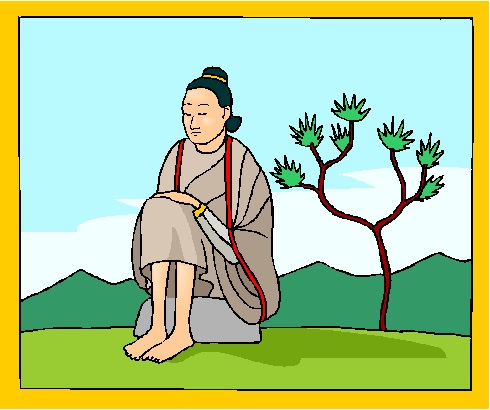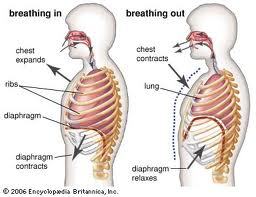If you are overwhelmed with the intricacies of tai chi breathing then this is going to be refreshing for you. The process of tai chi breathing for beginners is easy because your job is just to learn the movements of the form. Breathing will improve just from learning the form and practicing. Once you complete the form and have been practicing for a while, questions always arise about what breathing during tai chi should be like.
Tai chi breathing is deep, abdominal breathing where inhales and exhales are coordinated with movements of the body. As a general rule, breathing is continuous while inhaling through the nose and exhaling through your mouth. Tai chi breathing patterns relax the nervous system to reduce stress and improve wellbeing as well as teach how to store breath to power punches, kicks, and throws.
The good news is that there are just 9 tai chi breathing patterns that will get you correctly breathing during tai chi to get you all of the health and relaxation benefits. Let’s start with a few misunderstandings about how to breathe during the tai chi form so that suggestions that follow make more sense.
Depending on your interest or health needs, there are tons of new resources and writing coming out on meditation instructions and details on breathwork.
How important is tai chi and breathing while doing the form?
It is important to begin by talking about a big misconception about breathing while doing tai chi. The movements of tai chi are so scripted that it is natural to think that there are corresponding breathing patterns that exactly match up with each movement. However, too much focus on the breath takes us away from the main reason we are doing the form; which is to relax and return the body to a sense of equilibrium.
Secondly, tai chi breathing is hard to define as being one exact thing because throughout the form different breathing patterns are acceptable. Typically we want long continuous breaths but short quick breaths are also employed during powerful movements and for quick transitions. So breathing is always low and full into the belly but can happen at different speeds and you can take in different volumes.
Thirdly, trying to standardize instructions for movements and breathing completely ignores what state you are in when you begin the form. For example, on any given day I can arrive at class: hyper from too much coffee, exhausted from a long day at work, happy, under the weather, chilled, or sweating from the heat. How I am breathing at the beginning of the form is very different from how I end it. The goal is always to move towards a calm slow, strong state of breathing but we arrive there coming from many different states.
Fourthly, each of us has different lung capacities, coordination, and speed of movements. If you are trying to match a classmate or teacher, it will not be right for you.
There are various tai chi breathing exercises which isolate breath-work in standing postures or with minimal movements. This is fine. Deep breathing techniques for example is also incredibly specific and many qi gong sets purposefully manipulate breath. In this essay I am talking about breathing that takes place during the tai chi forms.
How to Breathe During Tai Chi
The question of how to breathe during tai chi is one of the most aggravating and frustrating for most practitioners. We hear this:
“Breathing is the most important aspect of Tai Chi because breath is life!”
But we also hear this:
“Just breathe naturally.”
And what about this?
“There is no Chi in Tai
Chiif you don’t know how to breathe.”
While the fact is that:
Tai Chi instruction begins with form work sometimes for months, before breathing is addressed. If it is so important, how come we don’t do like some yoga styles and teach breathing first and then incorporate it into the moves?
Here is the truth, you have to learn the form first to be able to understand the ins-and-outs of breathing. Breathing is just one of several important considerations when you are starting tai chi. Learning tai chi breathing exercises that you will later put into the form doesn’t lead to progress. Instead, we begin by learning the form and talk about breathing as we go along. From my experience teaching, there are three main hurdles to teaching separate tai chi breathing exercises whereas learning the form first gets you past them.
Breathing Problem #1: It’s Psychological
There is a mental part to breathing where you are thinking about your breath and moving it around in your body. For most of us in the West, this is completely new territory and a bit much to ask when we already have the difficulty of learning the form. This doesn’t mean it’s difficult. You just need some familiarity with the form to understand it. I have worked with two-week-new practitioners and they were able to get to a level of “feeling” their chi after one workshop from breathing correctly. It is not esoteric, it is mechanical. It is not something most cultures have experienced so you have to be instructed to look for it.
Breathing Problem #2: It’s a Secret!!!
Some would have you believe that tai chi breathing is a higher level skill that is only passed down to higher level students of great masters. Okay, maybe. In those situations, the breathing is practiced separately and is more often associated with qi gong. But when we are talking about getting new to medium-term practitioners to breathe correctly, it is no secret. Every time I hear someone talk about “secrets” this is what I think they are actually saying:
I have this ability but I am not skilled enough to teach it.
Or:
I don’t have this ability but still make myself look knowledgeable.
And/or:
I would like you to pay me.
Breathing Problem #3: It’s Esoteric

Here is how it’s esoteric: You can develop your breathing to a level of turning off your mind and using imagery to interact with what feels like everything at once: a.k.a the universe. It is beautiful and a noble pursuit. This is achievable after a ton of work.
Here is how it is not. It is physiological. You are timing your breath with the constrictions of your muscles to maximize blood flow. You are sending messages to your parasympathetic system to calm down. You are elongating your breath and breathing into the belly to maximize oxygen uptake. You are inhaling only through your nose which increases your attention. The olfactory system is the only sense without a cortex. In basic terms, the nose is wired directly into the brain. No going to the visual cortex, auditory cortex, or anywhere else to process information. Smelling is processing.
9 Guidelines to get the most benefit out of tai chi breathing.
Not having a breathing prescription per se does not mean that we breathe willy-nilly. Instead, we can adhere to a certain set of guidelines throughout the form.
1. Breathe out long enough so that you feel like you need to take a deep breath.
2. Your exhale should be slightly longer than your inhale.
3. Keep your tongue on the roof of your mouth. Say “la” and notice where the tongue goes. Place the tip of the tongue here when practicing tai chi.
4. Primarily inhale and exhale through your nose. Use mouth breathing only if you’re suffering from allergies, colds, or other types of nasal congestion.
5. Aim for a long, continuous breath without a pause between the inhale and exhale. Breathing should not stop.
6. Breathe into the belly. The changing pressure on your organs while your breathe gives them a massage.
7. When you’re inhaling (storing energy), think of taking in the life energy-oxygen- into your body. When you deliver energy or force, you exhale.
8. When your hands move apart breathe in, you are storing energy. When your hands come together you are delivering energy so breathe out.
9. When your hands move up, breathe in, you are storing energy. When your hands move down, breathe out, you are delivering energy again.
Note that there is one caveat to the general suggestions: all strikes are exhales. The general guidelines apply to movements throughout the form. If these movements are being applied to fighting, the breathing should be changed.
The most important point about breathing is that you breathe first before initiating any movement. Your intention is there in your belly, you initiate your breathing, and then you begin the movement.
Reasons why NOT to over-concentrate on breathing during tai chi.

Hopefully you see that breathing while you are doing tai chi is a relatively relaxed process that should not be over done. Over-concentrating on breathing can have some undesirable consequences.
- Holding of the breath causes an anxiety response and can stress us out. For some new practitioners who are trying to learn to breathe correctly, they hold their breath between moves. This doesn’t help with relaxation or learning the continuous nature of the movements.
- Too much pressure (like what is used purposefully in qi gong breathing) can push the chi in the wrong direction. On the other hand, relaxation causes energy to correctly sink to the dantian or to the feet.
- Becoming sensitive enough to feel energy moving in your body is dependent on the free movement of breath. You have to learn how to feel and sense your breath before you can manipulate it.
- Worst case scenario, too much pressure can lead to intestinal problems or even hemorrhoids if you are exerting force while not breathing.
How to improve breathing during tai chi and chi flow.
For those of you interested in feeling chi in your hands and your body and manipulating it with your breath, start by thinking about your armpits and inguinal crease (kua). The blood vessels that pass through your armpits and join from the legs into the inferior vena cava are huge! Garden hose like! If you crimp this garden hose, blood flow is restricted. So imagine keeping a racquetball in your armpits throughout your movements. Do not lock your back leg – Japanese style, which will close down the crease at your groin.
So that’s breathing and movement in tai chi. Let’s move on to discuss a type of breathing we use to build up energy in our body: reverse breathing.
What is Reverse Breathing?
Reverse breathing is the process of inhaling as the abdomen constricts and exhaling as the belly relaxes. It is used in internal arts to: move energy around the body, heal joints and tissue by focusing intention and breath on an area, deepening a meditative state, and storing energy to issue power.
Is reverse breathing bad for you or unnatural?
Reverse breathing has gotten a bit of a bad rap as being dangerous for us because of the manipulation of breath that is included in hard qi gong practices and other more advanced (read: should have a highly skilled guide) internal arts. However, reverse breathing is a completely normal process that is undertaken by the autonomic system and the subconscious. Here are three examples:
Emotional Reactions

When your emotional mind is amped up your body switches your breathing so that you can flee, scream, or attack. Think of someone jumping out from behind a door to scare you. Your whole upper body is tense and your stomach remains taut but you still manage to rapidly inhale deeply to scream. Belly laughter is also reverse breathing. Crying is typically fast reverse breathing with your belly expanding on the exhales.
Yawning is reverse breathing
Did this picture make you yawn? When we yawn we inhale profoundly and slowly while controlling our core muscles.
Pushing a car
You would not try to push a car while regular breathing or you would injure your back. Assume a pushing posture and imagine a heavy object you are about to move. What happened to your abdominal muscles? They automatically tensed to employ the stable force of the ground.
We can actively engage this natural process of reverse breathing for health and martial benefits.
Reverse Breathing Benefits

Mindful breathing is central to all internal practices. According to internal practices such as tai chi, qi gong, or yoga, when we inhale we are bringing healthy energy (qi) into the body and when we are exhaling we are expelling used or toxic energy outward.
Reverse breathing is the basis for leading qi to injuries to enable healing. When we inhale we place our attention on the joint. When we exhale, we bring the breath out to the surface of the skin.
Reverse breathing benefits us by allowing highly oxygenated breath to permeate the body. Decreased oxygen intake correlates with most health issues:
- Weakness from illness
- Weakness from muscle loss due to age
- Weight gain realigning intercostal muscles and putting pressure on the chest.
- Exposure to allergens and toxins (emphysema , asthma, pollen allergies, etc.)
- Postures related to fear
- Postures during poor sitting
In the winter we inhale longer than we exhale to retain energy and close the pores of the skin. Summertime brings the opposite reaction as we exhale longer to lead heat out of the body.
How to practice reverse breathing

Reverse breathing is most easily practiced by thinking about two body parts. We need to maintain the 1) abdominal muscles and elevate and relax the perineum (Huiyin Cavity). This Dummies webpage has a really good description of the perineum if this is new for you.
Before we start, it is important to note that we are manipulating the abdomen and the perineum as we respond to the breath. We are not forcefully moving the body parts to cause ourselves to breath differently.
Secondly, the pressure and pushing involved in reverse breathing is extremely gentle. Hard Qi Gong styles ramp it up here but this is not what we are discussing. It is a slow, light, meditative sensation that we are after.
The Abdomen
Breathe deeply and maintain the ab muscles as they are. It will feel as though your breath is actually sliding down your back and filling the abdominal cavity with pressure. Exhale and relax your stomach. No one is watching. Embrace your inner Buddha and let the belly out.
The Perineum
The Huiyin (literally: meeting of Yin) Cavity is considered the gate and meeting point of the 4 Yin Vessels. As you inhale you gently pull up on the anus from the inside. No puckering or tilting your pelvis. As you exhale you let the perineum drop and the anus relax.
Know that this process is awkward at first and takes practice. Newcomers often unintentionally create tension in the abdomen which causes us to hold our breath. Start small with shorter breathes and in a seated position. Concentrate on practicing the breathing in isolation before trying to (re-) incorporate the breathing into qi gong, yoga, or martial movements. Frequent short practices are best. I first got the hang of it by practicing when caught at red lights!
References:
Back Pain Relief: Simple Qigong Exercises for Healing & Prevention: Dr. Yang, Jwing-Ming
Qi in Taijiquan is an Intention Wave: Tai Chi Magazine. Vol 39, No. 2.
Continue Reading: The Science Behind 4 Powerful Deep Breathing Techniques



Excellent advice! Smile, Slow down and Breathe. Thanks for sharing!
Breathe is the one thing that all the different arts have in common. What ever we are doing (yoga, pilates, dance, tai chi,…) we want to be in a better place than we were when we started. I wish we could say that about our work days more frequently!
Thank you! Very good article.
Glad you liked it. This stuff can get thick some times so it is nice to know that some things take less effort than we may be putting into them.